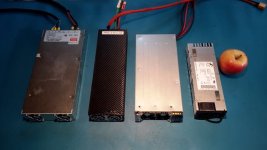Doctorbass
100 GW
Guys i think i have found the world most compact and powerfull charger ever 8)
It's a ELTEK 1.8kW flatpack S !!
These are availlable in 24 and 48V and take from 100 to 240V.
But what is fantastic is that they have the unbeatable 47 W/cu inch density !! and are 96.5% efficient!!!
These are the size of these cheap 2A 48V charger!!!
I will fit one or two in my NYX frame.
By modifying one i was able to shorten it to about 7.5" long!!
These are 2.8 x 1.6 x 8.5" size.
I contacted the Canadian representative of these and i will get a quote for more.. These are perfect to combine with the Adaptto.
They are OEM 53.5V and 33.7A and output 1800W on 240V ac input and about 1000W on 120V ac
I had no BANANA gus .. very sorry for that.. I only had apple
But see how small it is !!
I also atached a comparaison between some popular rectifiers ( server power supply we use on E-S)
Doc
It's a ELTEK 1.8kW flatpack S !!
These are availlable in 24 and 48V and take from 100 to 240V.
But what is fantastic is that they have the unbeatable 47 W/cu inch density !! and are 96.5% efficient!!!
These are the size of these cheap 2A 48V charger!!!
I will fit one or two in my NYX frame.
By modifying one i was able to shorten it to about 7.5" long!!
These are 2.8 x 1.6 x 8.5" size.
I contacted the Canadian representative of these and i will get a quote for more.. These are perfect to combine with the Adaptto.
They are OEM 53.5V and 33.7A and output 1800W on 240V ac input and about 1000W on 120V ac
I had no BANANA gus .. very sorry for that.. I only had apple
But see how small it is !!
I also atached a comparaison between some popular rectifiers ( server power supply we use on E-S)
Doc





